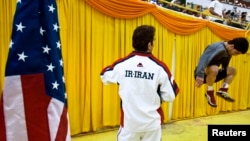While U.S. and Iranian negotiators labor to reach a long-term nuclear agreement, other Americans and Iranians are stepping up contacts in a new wave of people-to-people diplomacy.
In recent months, three American religious delegations have visited Iran while the first group of female Iranian seminary students came to the United States.
Sports exchanges are also on the rise again, spearheaded by American wrestlers who find far more numerous and passionate fans in Iran than in many countries, including the U.S.
Robby Smith, 27, of San Ramon, California, said he has been part of the U.S. team since he was 18 and wrestling since he was 4 but never experienced the welcome and popular interest he did in Iran in May. People stopped him on the street to have their pictures taken with him, shopkeepers gave him gifts and fans chanted “USA! USA!” when he was competing in the Greco-Roman wrestling world cup.
“It took me six minutes to become a hero in Iran” after years of relative obscurity in the U.S., he told VOA. “I felt like a Beatle…This is something I will always remember my whole entire life and the Iranian people gave that to me.”
National obsession
Wrestling occupies a special place in Iran where it is second only to soccer as a national obsession. Other sports are popular too, such as volleyball; Iran’s national team will be coming to southern California next month to take part in four matches against the U.S. team. Organizers hope this sort of competition will help humanize Iranians for an American public that, to the extent it thinks about Iran at all, regards the country as a member of an “axis of evil” that supports terrorism, wants nuclear weapons and opposes Israel.
This is the second big wave of people-to-people diplomacy with Iran since the 1979 Islamic revolution. The first came after the election of Mohammad Khatami as Iran’s president in 1997. Khatami called for a “dialogue of civilizations” and exchanges of academics, artists and athletes to break down what he called the “bulky wall of mistrust” between the U.S. and Iran.
American wrestlers were in the vanguard then, too, competing in a major competition in Tehran in February 1998. This reporter witnessed the scene as Iranian fans cheered as much or more for the Americans as they did for their own athletes. The American flag – often burned in demonstrations in Iran – flew unmolested in Azadi stadium. Other exchanges followed, engaging experts in education, health, astronomy, philosophy and theology, the environment and cinema.
Diplomacy
Hopes that these contacts would pave the way for normalized diplomatic relations faded, however, as Iranian hardliners undermined Khatami and the George W. Bush administration demonized Iran after profiting from its assistance in overthrowing the Taliban and forming a new government for Afghanistan in 2001. The 2003 U.S. invasion of Iraq added new complications.
The election of Mahmoud Ahmadinejad as Khatami’s successor in 2005 and especially Ahmadinejad's disputed re-election in 2009 further dampened prospects for improved U.S.-Iran relations and made it more difficult for Americans to get visas to visit Iran. With the election last year of Hassan Rouhani as president, however, the chances for a nuclear deal and overall détente with Iran have improved. The Rouhani government has made it clear that it welcomes private Americans and has facilitated visas for the recent delegations.
Since clerics are so influential in Iran – the country’s Supreme Leader, Ayatollah Ali Khamenei, is a Shiite Muslim cleric as our many of its other top officials – interfaith dialogue is a logical means of increasing U.S.-Iran understanding. Among the U.S. groups that have visited Iran this year has been a delegation of Roman Catholic Bishops, two dozen Mennonites and an eight-member multi-faith group that included a spiritual adviser to President Barack Obama, Florida mega-church pastor Joel Hunter.
The Roman Catholics drafted a joint declaration against the “production, stockpiling, use and threat to use weapons of mass destruction” that was signed by Bishop Richard Pates of Des Moines, Iowa, retired Washington, D.C. archbishop Cardinal Theodore McCarrick and two senior Iranian ayatollahs. The declaration was meant to formalize a “fatwa” or religious ruling by Khamenei against nuclear weapons.
McCarrick, speaking Thursday in Washington at a panel organized by the Middle East Institute, said the bishops spent much of their visit in March discussing “what a fatwa really is.” Despite skepticism by some outside Iran about the validity of the ruling, McCarrick said, “We found the fatwa of the Supreme Leader was very important – a document which had to be obeyed religiously.” The retired archbishop compared it to a papal declaration directed to the world’s Roman Catholics.
Ayatollah Ahmad Iravani, an Iranian-trained theologian who teaches at Catholic University and runs the non-profit Center for the Study of Islam and the Middle East, which promotes interfaith understanding, said the fatwa should also be considered an edict of the state, given Khamenei’s temporal position.
Critics of Iran often allege that people-to-people diplomacy is a kind of public relations stunt and that the Iranian government is using Americans of good will to distract attention from objectionable Iranian policies. Others note that the portions of the Iranian government that make decisions on the most sensitive issues regarding national security are not the ones taking part in such exchanges.
Iravani admitted that “we have limitations” and that there are “many areas outside our power and information.” But he said that people-to-people ties can help overcome misunderstanding and produce cooperation on projects of mutual benefit such as the environment.
McCarrick, meanwhile, said it would be more naïve for people not to try to make a difference.
“The only thing certain is that God loves us,” McCarrick said. “This is a new moment [in U.S.-Iran relations] and if we don’t seize it, we may never find it again.”









